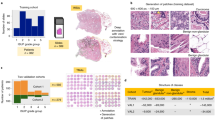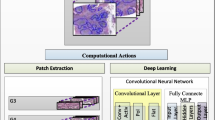Abstract
Pathologists diagnose and grade prostate cancer by examining tissue from needle biopsies on glass slides. The cancer’s severity and risk of metastasis are determined by the Gleason grade, a score based on the organization and morphology of prostate cancer glands. For diagnostic work-up, pathologists first locate glands in the whole biopsy core, and—if they detect cancer—they assign a Gleason grade. This time-consuming process is subject to errors and significant inter-observer variability, despite strict diagnostic criteria. This paper proposes an automated workflow that follows pathologists’ modus operandi, isolating and classifying multi-scale patches of individual glands in whole slide images (WSI) of biopsy tissues using distinct steps: (1) two fully convolutional networks segment epithelium versus stroma and gland boundaries, respectively; (2) a classifier network separates benign from cancer glands at high magnification; and (3) an additional classifier predicts the grade of each cancer gland at low magnification. Altogether, this process provides a gland-specific approach for prostate cancer grading that we compare against other machine-learning-based grading methods.
Access this chapter
Tax calculation will be finalised at checkout
Purchases are for personal use only
Similar content being viewed by others
References
Abbasi Koohpayegani, S., Tejankar, A., Pirsiavash, H.: Compress: self-supervised learning by compressing representations. In: Larochelle, H., Ranzato, M., Hadsell, R., Balcan, M.F., Lin, H. (eds.) Advances in Neural Information Processing Systems. vol. 33, pp. 12980–12992. Curran Associates, Inc. (2020). https://proceedings.neurips.cc//paper/2020/file/975a1c8b9aee1c48d32e13ec30be7905-Paper.pdf
Avenel, C., Tolf, A., Dragomir, A., Carlbom, I.B.: Glandular segmentation of prostate cancer: an illustration of how the choice of histopathological stain is one key to success for computational pathology. Front. Bioeng. Biotechnol. 7, 125 (2019). https://doi.org/10.3389/fbioe.2019.00125, https://www.frontiersin.org/article/10.3389/fbioe.2019.00125
Bulten, W., et al.: Epithelium segmentation using deep learning in H &E-stained prostate specimens with immunohistochemistry as reference standard. Sci. Rep. 9, 864 (2019). https://doi.org/10.1038/s41598-018-37257-4
Bulten, W., et al.: The panda challenge: prostate cancer grade assessment using the Gleason grading system, March 2020. https://doi.org/10.5281/zenodo.3715938
Doersch, C., Zisserman, A.: Multi-task self-supervised visual learning. In: 2017 IEEE International Conference on Computer Vision (ICCV), pp. 2070–2079 (2017). https://doi.org/10.1109/ICCV.2017.226
Drozdzal, M., Vorontsov, E., Chartrand, G., Kadoury, S., Pal, C.: The importance of skip connections in biomedical image segmentation, August 2016. https://doi.org/10.1007/978-3-319-46976-8_19
Ferrero, A., Elhabian, S., Whitaker, R.: SetGANs: enforcing distributional accuracy in generative adversarial networks, June 2019
Gavrilovic, M., et al.: Blind color decomposition of histological images. IEEE Trans. Med. Imaging 32(6), 983–994 (2013). https://doi.org/10.1109/TMI.2013.2239655
Girshick, R.: Fast R-CNN. In: 2015 IEEE International Conference on Computer Vision (ICCV), pp. 1440–1448 (2015). https://doi.org/10.1109/ICCV.2015.169
He, K., Gkioxari, G., Dollar, P., Girshick, R.: Mask R-CNN. In: 2017 IEEE International Conference on Computer Vision (ICCV), pp. 2980–2988 (2017). https://doi.org/10.1109/ICCV.2017.322
He, K., Zhang, X., Ren, S., Sun, J.: Spatial pyramid pooling in deep convolutional networks for visual recognition. IEEE Trans. Pattern Anal. Mach. Intell. 37(9), 1904–1916 (2015). https://doi.org/10.1109/TPAMI.2015.2389824
He, K., Zhang, X., Ren, S., Sun, J.: Deep residual learning for image recognition. In: 2016 IEEE Conference on Computer Vision and Pattern Recognition (CVPR), pp. 770–778 (2016). https://doi.org/10.1109/CVPR.2016.90
Li, J., Sarma, K., Ho, K.C., Gertych, A., Knudsen, B., Arnold, C.: A multi-scale u-net for semantic segmentation of histological images from radical prostatectomies. In: AMIA Annual Symposium Proceedings, pp. 1140–1148. AMIA Symposium 2017, April 2018
Li, W., et al.: Path R-CNN for prostate cancer diagnosis and Gleason grading of histological images. IEEE Trans. Med. Imaging 38(4), 945–954 (2019). https://doi.org/10.1109/TMI.2018.2875868
Lokhande, A., Bonthu, S., Singhal, N.: Carcino-net: A deep learning framework for automated Gleason grading of prostate biopsies. In: 2020 42nd Annual International Conference of the IEEE Engineering in Medicine Biology Society (EMBC), pp. 1380–1383 (2020). https://doi.org/10.1109/EMBC44109.2020.9176235
Long, J., Shelhamer, E., Darrell, T.: Fully convolutional networks for semantic segmentation. In: The IEEE Conference on Computer Vision and Pattern Recognition (CVPR), June 2015
Ma, J.: Histogram matching augmentation for domain adaptation with application to multi-centre, multi-vendor and multi-disease cardiac image segmentation (2020)
Ma, Z., Li, J., Salemi, H., Arnold, C., Knudsen, B., Gertych, A., Ing, N.: Semantic segmentation for prostate cancer grading by convolutional neural networks, p. 46, March 2018. https://doi.org/10.1117/12.2293000
Nagpal, K., et al.: Development and validation of a deep learning algorithm for improving Gleason scoring of prostate cancer. NPJ Digital Med. 2, 48 (2019). https://doi.org/10.1038/s41746-019-0112-2
Ronneberger, O., Fischer, P., Brox, T.: U-net: convolutional networks for biomedical image segmentation. In: Navab, N., Hornegger, J., Wells, W.M., Frangi, A.F. (eds.) MICCAI 2015. LNCS, vol. 9351, pp. 234–241. Springer, Cham (2015). https://doi.org/10.1007/978-3-319-24574-4_28
Silva-Rodríguez, J., Payá-Bosch, E., García, G., Colomer, A., Naranjo, V.: Prostate gland segmentation in histology images via residual and multi-resolution U-NET. In: Analide, C., Novais, P., Camacho, D., Yin, H. (eds.) IDEAL 2020. LNCS, vol. 12489, pp. 1–8. Springer, Cham (2020). https://doi.org/10.1007/978-3-030-62362-3_1
Zheng, X., Wang, Y., Wang, G., Liu, J.: Fast and robust segmentation of white blood cell images by self-supervised learning. Micron 107, 55–71 (2018). https://doi.org/10.1016/j.micron.2018.01.010
Acnowledgments
We acknowledge the generous support from the Department of Defense Prostate Cancer Program Population Science Award W81XWH-21-1-0725-. We also acknowledge that we received the training data from Cedars-Sinai Hospital in Los Angeles and we thank Dr. Akadiusz Gertych for his work on establishing the tiles. The results presented here are in part based upon data generated by the TCGA Research Network: https://www.cancer.gov/tcga.
Author information
Authors and Affiliations
Corresponding author
Editor information
Editors and Affiliations
Rights and permissions
Copyright information
© 2022 The Author(s), under exclusive license to Springer Nature Switzerland AG
About this paper
Cite this paper
Ferrero, A., Knudsen, B., Sirohi, D., Whitaker, R. (2022). A Pathologist-Informed Workflow for Classification of Prostate Glands in Histopathology. In: Huo, Y., Millis, B.A., Zhou, Y., Wang, X., Harrison, A.P., Xu, Z. (eds) Medical Optical Imaging and Virtual Microscopy Image Analysis. MOVI 2022. Lecture Notes in Computer Science, vol 13578. Springer, Cham. https://doi.org/10.1007/978-3-031-16961-8_6
Download citation
DOI: https://doi.org/10.1007/978-3-031-16961-8_6
Published:
Publisher Name: Springer, Cham
Print ISBN: 978-3-031-16960-1
Online ISBN: 978-3-031-16961-8
eBook Packages: Computer ScienceComputer Science (R0)





